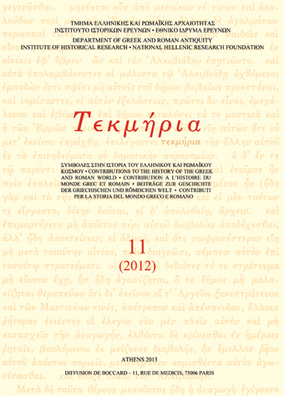The Composition of the Peloponnesian Elites in the Roman period and the Evolution of their Resistance and Approach to the Roman Rulers
Part of : Τεκμήρια ; Vol.9, 2008, pages 25-51
Issue:
Pages:
25-51
Section Title:
Articles
Author:
Abstract:
This paper examines the composition of the Peloponnesian elites during the Roman period and traces the interaction between them and the Roman ruling power. The period under examination extends roughly from the time of Polybios, who was the first known cultured Greek and Peloponnesian attached to Romans, to the time of Plutarch, whose attitude to Romans certainly influenced educated individuals of the Péloponnèse who were evidently in contact with him. The process of gradual approach between Peloponnesians and Romans includes also certain breaks of opposition, which —even its most violent instances, such as the events of Dyme (144/143 B.C.)— were, however, actually not revolts against Roman government generally, but resistance against certain policies of Roman magistrates or emperors. The most prominent citizens of the Peloponnesian towns always played a central role either as inciters of a «revoluntary» action and protest and as «channels» conveying complaints of the towns to the Roman authorities, or as links between local circles and the Roman central power. Their personal connections with Roman magistrates and emperors were in any case firmed in the course of time. The increase of such connections, which is also to be indirectly inferred from the study of onomastics, is also vitally inprinted in an overview of the honorary monuments for representatives of the Roman power, which were set up not by state authorities but by private individuals. It arises that private honours for Roman magistrates are extremely rare in the Republican period. They increase during the Imperial period and their vast majority is to be dated during the 1st c. A.D. and till the reign of Hadrian, when Peloponnesian notables aspire to create more and more personal bonds with emperors and their families and with functionaries of the provincial administration. In the period after Hadrian the number of honorary monuments erected by individuals is reduced, which probably reflects a consolidation of the patronage nets, the increased financial obligations of the elite and the first signs of the «crisis» of the 3rd c. The elites of the old towns of the Péloponnèse —the three Roman colonies of the region are left aside— are composed of prominent groups of various origins. In some cases it is evident that the prominent families of the first two centuries of the Imperial period already used to play an important role in public life of their home towns for several generations. Although there were also cases of newfangled notables with wealth and connections, we cannot speak of a gap or of a disappearance of the old aristocracy and establishment of a new elite. Thus, the Peloponnesian elite includes the old aristocracy, individuals that appear only for short periods as leading members of local societies, individuals that rose to power in the circumstances of depression of the late Republic and descendants of well-established negotiator es. Connections with Roman settlers and ties with Roman colonies, especially Corinth, were important for advancing the careers of Peloponnesian notables. Some of them were indeed embarked on the equestrian and senatorial ranks of the Roman society. Local nobilities are united through marriages, friendships, common interests and common Roman patrons creating nets of power beyond the limits of their home towns.
Subject:
Subject (LC):




